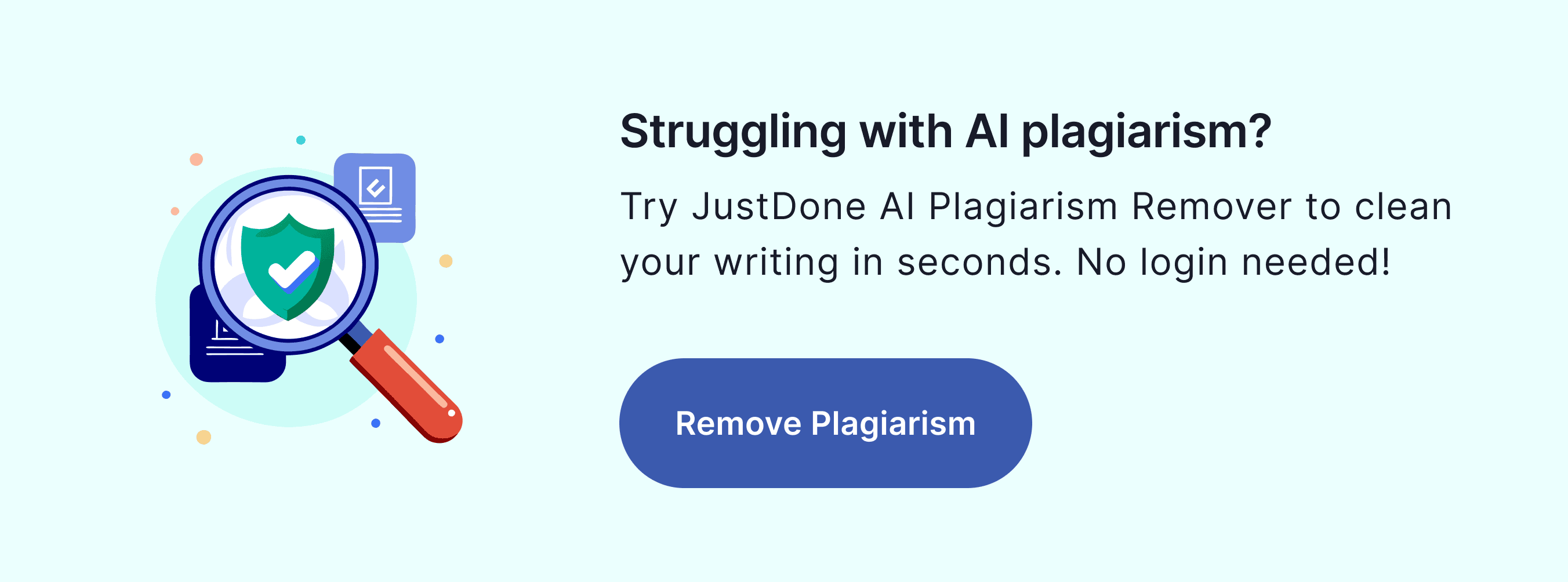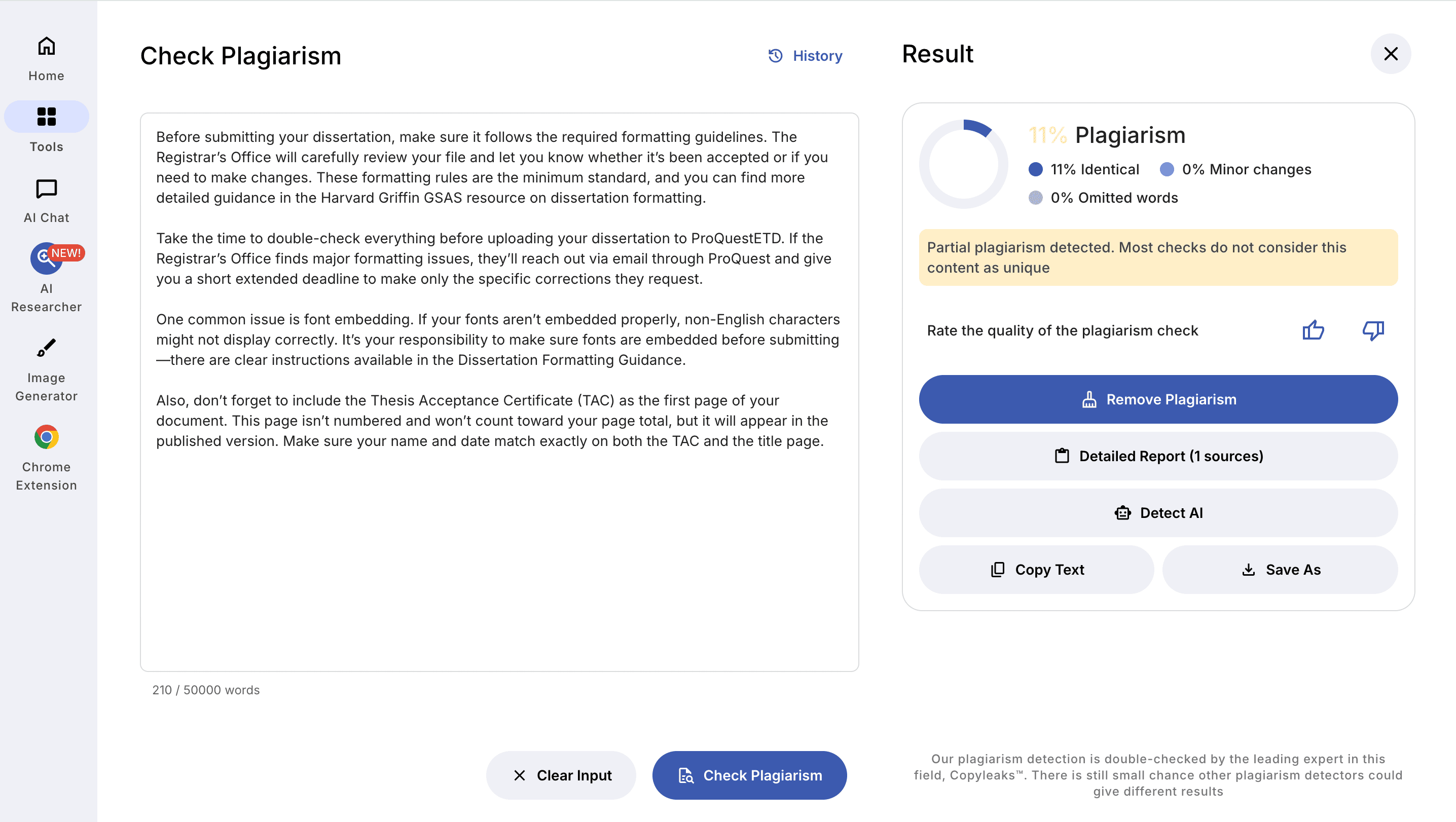Picture this: you’ve just completed a big essay, and you feel proud of how everything ties together. But then a little voice in your head asks: “Is any of this accidentally AI-generated or plagiarized?” It's a common situation. These tools (plagiarism checkers and AI detection) can sound intimidating, but they actually make your writing stronger.
In this article, I'll unpack these questions: What’s the real difference between plagiarism and AI checker? Do plagiarism checkers detect AI? Can text be flagged by an AI and plagiarism detector? What are the best free AI detector and plagiarism tools? Let’s dive in.

Plagiarism Checkers vs. AI Detection: Why They Are Different
When we talk about how plagiarism checkers work and what they are, think of detectives scanning your text for direct matches to published sources. These tools, like JustDone’s plagiarism checker, Turnitin, or Grammarly, highlight passages that appear copied or too close to existing text. They typically report a similarity score and show you exactly which sentences match which sources.
On the other hand, AI detection tools don’t compare text with a database of published works. Instead, they analyze the language patterns, such as the rhythm, phrase structure, and tone. If your writing lacks the usual quirks and variations of a human writer, these detectors may flag it as machine-generated. JustDone’s AI detector, GPTZero, and Copyleaks are examples of such tools.
Recent research shows that Turnitin, the gold standard of academia, found that about 11% of student papers reviewed had AI-written content in at least 20% of the document, and 3% of papers had 80% or more AI writing. They also assert a false positive rate below 1% for full documents under those conditions.
So, when someone asks, do plagiarism checkers detect AI, the honest answer is no, not usually. And if you’re wondering, can AI be detected for plagiarism, keep in mind, even original AI-generated text isn’t “plagiarized” unless it copies existing content. That’s why both tools are essential for students who want both originality and authenticity.
Why AI and Plagiarism Detector Matter: A Personal Perspective
I remember the first time I submitted a research paper in college. I was so careful to cite all my sources, but didn’t think to run an AI checker. A classmate used a paragraph that looked okay, but his sentence structure was eerily perfect. When our instructor flagged it as AI-generated, he barely escaped a low grade. It was a wake-up call for all of us.
Since then, I've made it a practice to use both tools. I run the plagiarism checker first to ensure I didn’t copy anything unintentionally. Then I feed the final text into an AI detector. If it comes back flagged, I rewrite sections more naturally, inject personal stories or opinion, and recheck until the tone feels true to me.
That two-step routine keeps my academic integrity solid and helps me write with confidence.
Free Plagiarism and AI Checker Tools Students Can Use
I know many students have tight budgets. There are excellent free or freemium tools that cover both plagiarism and AI detection.
For plagiarism, JustDone’s free checker is surprisingly powerful. I tested it on a Wikipedia intro – it flagged the entire paragraph, showed the source URL, and after I paraphrased and added a citation, the score dropped to near-zero. That immediate feedback is gold.
For the AI side, GPTZero is a solid free option. I ran a paragraph I had paraphrased from an academic paper and initially wrote it in a dry, overly formal tone. GPTZero flagged it as “likely AI.” I rewrote it to sound more conversational, changing sentence lengths and adding personal insight, and it helped transition to “likely human.” That moment of realization taught me how much tone matters.
Other free detectors like Copyleaks also do a decent job, though they limit the number of free checks. Combined, these tools offer students an affordable route to polished, authentic writing.
Here's a quick overview of all you need to know about AI detectors and plagiarism checkers.
What Students Ask About These Tools
Here are the 5 most often asked questions students should know about plagiarism checkers and AI detectors:
| Question | Answer |
|---|---|
| Do plagiarism checkers detect AI? | No, they match text to sources, not writing style. |
| Can AI be detected for plagiarism? | Only if AI copied existing text; original AI text won’t register. |
| Free plagiarism checker + AI tool? | Yes, tools like JustDone, GPTZero, Copyleaks offer free tiers. |
| Which is better for essays? | Both: plagiarism to check citation, AI detection to ensure original tone. |
| What score is "too AI"? | Not more than 15% if use AI checker. No fixed percent by plagiarism checkers, but aim for low AI detection and human tone overall. |
Testing It Out: My Two-Step Test In Action
As studies show, some leading tools like Originality or Winston AI reach over 97% accuracy in detecting AI-plagiarism, with false positive rates for human content under 3%. Also, it points out that OpenAI's own text classifier performs poorly and demonstrates 26% in that test.
I did my own test with other tools. I selected a journal article on writing a dissertation and extracted a few paragraphs.
First, I plugged this into JustDone’s plagiarism checker. It flagged it as 11% matched with the journal source. I paraphrased it, even expanded it with my own examples about melting glaciers, and cited it properly. The similarity score dropped to a respectable 5%.

Then, I scanned the revised text through AI detector. It flagged the overly academic tone, so I tweaked it further: made it more conversational, added a sentence about why this topic matters to me personally (I'm from a coastal town where we’ve seen rising tides). After those adjustments, the AI detector rated it as “likely human.” Job done.
This example hit both marks: no unintentional plagiarism, and a natural tone that doesn’t scream “AI wrote me.”
How to Spot False Positives
Both types of tools can make mistakes. As this research shows, false positive results are the trickiest and especially affect non-native English speakers. That means a student who writes more creatively or with less standard structure is more likely to be flagged, even if they don't use AI.
Academic phrases like “In conclusion” or “The study indicates” may trigger plagiarism alerts, even if legitimately cited. Some AI detectors can be overly cautious about formal writing.
When your text gets flagged, don’t panic. These tools are guides, not judges. If a detector flags something as AI-generated, ask: Does it sound robotic? Are all your sentences the same length? If so, rewrite for variety and personality. If the plagiarism checker highlights a phrase you cited properly, double-check that the quote is in quotation marks or properly paraphrased, and move on.
Bottom Line: Write With Integrity and Your Own Voice
Plagiarism checkers and AI detectors aren’t adversaries. They’re valuable allies in achieving two important goals: to ensure your sources are credited and to make sure your voice remains your own.
When my students go through this process, I encourage them to think step by step:
- Use a plagiarism checker first to remove the risk of copying.
- Rewrite flagged passages in your own words and cite appropriately.
- Run the revised text through an AI detector.
- Improve the tone until it feels you; add personal anecdotes, sentence rhythm, or even small mistakes.
- Double-check everything, including quotations and citations.
It may sound like a lot, but once practiced, it becomes routine and fast. Plus, you'll submit with the confidence that your work is authentically yours.
Final Thoughts on Plagiarism and AI Detectors
Plagiarism and AI checkers serve different purposes: one tests what you wrote (source originality), the other tests how you wrote it (human touch). As a student, using both, followed by human review, is your best path to integrity and authenticity. Tools like JustDone offer both services under one platform, and their free tier is a great start. But none can replace your judgment. Always aim for clarity, personal voice, and proper citations. Ultimately, tech can guide you, but your thinking is the real star of the show.